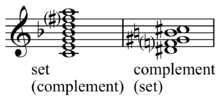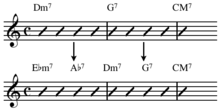Outside (jazz): Difference between revisions
{{Jazz theory}} |
Steelstreet (talk | contribs) m I added a reference to super-arpeggios which is related to playing outside in jazz vocabulary terms |
||
| Line 19: | Line 19: | ||
One technique used for sideslipping is the addition of distant [[ii-V-I turnaround|ii-V]] relationships, such as a half-step above the original ii-V. This increases chromatic tension as it first moves away and then towards the tonic.<ref>Richard Lawn, Jeffrey L. Hellmer (1996). ''Jazz: Theory and Practice'', p.119. ISBN 0-88284-722-8.</ref> |
One technique used for sideslipping is the addition of distant [[ii-V-I turnaround|ii-V]] relationships, such as a half-step above the original ii-V. This increases chromatic tension as it first moves away and then towards the tonic.<ref>Richard Lawn, Jeffrey L. Hellmer (1996). ''Jazz: Theory and Practice'', p.119. ISBN 0-88284-722-8.</ref> |
||
Playing 'outside' is similar to stacking chords to use the chord extensions that 'colour' modern jazz bebop harmony. Charlie Parker would play 9ths, #11ths, 13ths by playing D7 over C7 for example. Thus the melody line immediately uses the extended tones of C Mixolydian and creates more 'interesting' solos because of the bigger pallet available. Playing outside/side-slipping and using these 'super-arpeggios' [D7 over C7] all gives for a more expressive melodic vocabulary, and is how modern jazz evolved with Bebop. |
|||
==See also== |
==See also== |
||
Revision as of 13:35, 26 November 2012



In jazz, side-slipping, sidestepping, or outside playing, is a technique in which, during improvisation, one plays only the five "'wrong'" non-scale notes for the given chord and none of the seven scale or three to four chord tones, given that there are twelve notes in the equal tempered scale and heptatonic scales are generally used.[1]
In the example on the rhythm changes B section to the right, the (heptatonic) scale for each chord would be:
E7 - E mixolydian A7 - A mixolydian D7 - D mixolydian G7 - G mixolydian C - C major
Thus the non-scale notes would be those of the following (pentatonic) scales:
E7 - E♭ major pentatonic A7 - A♭ major pentatonic D7 - D♭ major pentatonic G7 - G♭ major pentatonic C - G♭ major pentatonic
One technique used for sideslipping is the addition of distant ii-V relationships, such as a half-step above the original ii-V. This increases chromatic tension as it first moves away and then towards the tonic.[2]
Playing 'outside' is similar to stacking chords to use the chord extensions that 'colour' modern jazz bebop harmony. Charlie Parker would play 9ths, #11ths, 13ths by playing D7 over C7 for example. Thus the melody line immediately uses the extended tones of C Mixolydian and creates more 'interesting' solos because of the bigger pallet available. Playing outside/side-slipping and using these 'super-arpeggios' [D7 over C7] all gives for a more expressive melodic vocabulary, and is how modern jazz evolved with Bebop.
